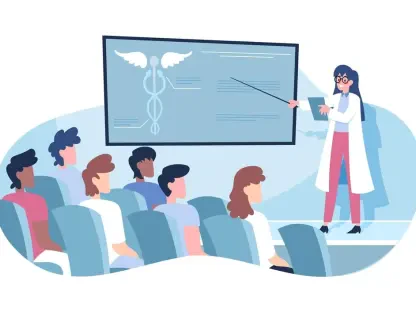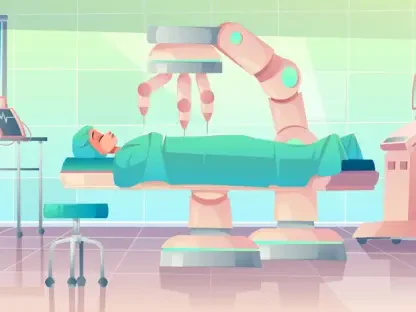Setting the Stage for Change in Nursing Education
Imagine a healthcare system where every patient, regardless of ability, receives compassionate, competent care tailored to their unique needs, yet in reality, individuals with disabilities often face significant barriers due to gaps in the training of healthcare providers. This discrepancy highlights a pressing challenge within nursing education: the urgent need to adapt curricula to ensure equitable care for persons with disabilities. As the healthcare industry evolves, the preparation of nurses to address these specific needs becomes a cornerstone of achieving true inclusivity. This report delves into the current state of nursing education, explores innovative trends, examines challenges, and outlines future directions to bridge the equity gap in disability care.
The nursing education sector stands at a critical juncture, with growing awareness of the disparities faced by individuals with disabilities in healthcare settings. Historically, many programs have focused on generalized medical training, often overlooking specialized instruction for diverse populations. This oversight has resulted in a workforce that, while skilled in many areas, may lack the confidence or expertise to handle the nuanced demands of disability care. Stakeholders across educational institutions, healthcare providers, and policy arenas are now recognizing the importance of curriculum reform to address these shortcomings, setting the stage for a transformative shift in how nurses are prepared for their vital roles.
Understanding the Current Landscape of Nursing Education and Disability Care
The present state of nursing education reveals a significant gap in addressing disability care, with many programs offering limited exposure to this critical area. While foundational medical knowledge remains a priority, specialized training for managing physical, sensory, or cognitive impairments is often minimal or absent. This gap contributes to inconsistent care quality for patients with disabilities, who may encounter misunderstandings or inadequate accommodations during treatment. Addressing this issue is essential to ensure that healthcare systems uphold equity as a core principle.
Equitable care for individuals with disabilities is not just a niche concern but a fundamental component of a just healthcare system. These patients often require tailored approaches, whether through adaptive communication methods or specific clinical interventions. Without adequate preparation, nurses may struggle to meet these needs, perpetuating disparities in health outcomes. Educational institutions and healthcare providers must prioritize this area to foster a workforce capable of delivering inclusive care across diverse patient populations.
Technological advancements are beginning to reshape nursing education, offering new tools to bridge existing gaps. Virtual simulations and digital learning platforms provide opportunities for students to practice disability care scenarios in safe, controlled environments. However, access to such innovations remains uneven, with some programs lacking the resources to implement cutting-edge teaching methods. Major stakeholders, including policymakers, must collaborate to ensure that these advancements are widely adopted, enhancing the readiness of future nurses to serve all patients effectively.
Trends and Developments in Nursing Education for Disability Inclusivity
Emerging Pedagogical Approaches and Training Innovations
Recent trends in nursing education signal a promising shift toward inclusivity through innovative teaching strategies. Interprofessional learning, where nursing students collaborate with peers from other healthcare disciplines, fosters a comprehensive understanding of patient care. Simulation-based training, another growing approach, allows learners to engage in realistic scenarios involving patients with disabilities, building practical skills before entering clinical settings. These methods are gaining traction as effective ways to prepare students for complex care demands.
Disability-specific modules are increasingly being integrated into curricula, equipping students with targeted knowledge on accessibility, adaptive care techniques, and cultural sensitivity. Such modules have shown a marked impact on student preparedness, enabling them to approach disability care with greater empathy and technical proficiency. Additionally, emerging technologies like virtual reality offer immersive experiences, simulating challenges faced by individuals with impairments, thus deepening students’ understanding of their unique perspectives.
Market drivers, such as heightened awareness of healthcare equity and rising demand for skilled nurses, are fueling these educational shifts. Public and private sectors are investing in training programs that prioritize inclusivity, recognizing the long-term benefits of a competent workforce. As societal expectations evolve, the push for nurses who can address diverse needs continues to grow, encouraging institutions to adopt forward-thinking approaches in their teaching frameworks.
Evidence of Effectiveness and Growth Potential
Data from recent studies underscore the effectiveness of adapted curricula in enhancing nursing students’ capabilities in disability care. A systematic review conducted by leading researchers highlights that students exposed to specialized training report significantly higher confidence levels when managing such cases. Moreover, their competence in delivering tailored interventions improves, directly benefiting patient outcomes through more personalized and effective care strategies.
Looking ahead, projections indicate substantial growth in inclusive education programs over the next few years, with the potential to reshape healthcare delivery. From this year onward, an increasing number of institutions are expected to adopt these models, driven by evidence of their positive impact. Student outcomes, including improved problem-solving skills in diverse scenarios, suggest that scaling these initiatives could create a ripple effect, elevating care standards across the industry.
Forward-looking perspectives emphasize the importance of replicating successful training models across varied educational settings. By sharing best practices and fostering collaboration among institutions, the reach and impact of inclusive programs can expand. This growth trajectory points to a future where nursing education consistently prioritizes equity, ensuring that all patients receive the high-quality care they deserve.
Challenges in Adapting Nursing Education for Disability Care Equity
Implementing curriculum reform in nursing education faces several barriers, notably resource constraints that limit the development of specialized programs. Many institutions struggle with funding shortages, making it difficult to invest in new training materials or hire faculty with expertise in disability care. Additionally, institutional resistance to change can hinder progress, as some programs prioritize traditional curricula over innovative adaptations, delaying necessary updates.
Technological challenges further complicate the adoption of advanced training tools essential for experiential learning. While virtual reality and simulation technologies hold immense potential, not all nursing schools have the infrastructure or budget to integrate them effectively. This disparity creates uneven access to cutting-edge education, leaving some students less prepared than their peers to address the needs of patients with disabilities in real-world settings.
Systemic issues, such as varying levels of readiness across educational and healthcare environments, pose additional obstacles. Some regions or facilities may lack the cultural or structural support needed to embrace inclusivity fully. Potential solutions include forging partnerships with disability advocacy groups to provide expertise and resources. Addressing faculty shortages through targeted recruitment and training initiatives also ensures consistent implementation of reforms, paving the way for sustainable change.
Policy and Regulatory Framework Impacting Nursing Education Reform
The regulatory landscape governing nursing education plays a pivotal role in shaping efforts toward disability care inclusivity. Current standards often lack explicit mandates for specialized training in this area, leaving curriculum design to the discretion of individual institutions. This inconsistency results in uneven preparation among graduates, highlighting the need for clearer guidelines that prioritize equitable care education as a core component of nursing programs.
Significant policies at national and regional levels can either promote or hinder progress in this domain. Mandates that require disability training as part of accreditation processes encourage institutions to adapt, while the absence of such policies allows gaps to persist. Compliance with existing regulations, when aligned with inclusivity goals, ensures that programs integrate relevant content, fostering a workforce better equipped to serve diverse populations.
Collaboration between policymakers and educators is essential to drive systemic change through policy-level interventions. Standardizing education reforms via updated licensing requirements or funding incentives can accelerate the adoption of inclusive curricula. Such efforts must focus on long-term impact, ensuring that regulatory frameworks evolve to meet the changing needs of healthcare systems and the patients they serve.
Future Directions for Nursing Education in Disability Care Equity
Looking to the horizon, nursing education is poised for significant transformation with a focus on inclusivity and equity. Emerging advancements in educational technology, such as artificial intelligence-driven simulations, promise to further enhance training by offering personalized learning experiences. These tools could revolutionize how students engage with disability care scenarios, preparing them for an increasingly complex healthcare landscape.
Societal attitudes toward disability are also shifting, influencing the direction of nursing training. Greater public awareness and advocacy for inclusion are pushing educational programs to prioritize empathy and cultural competence as core skills. This cultural evolution, combined with evolving healthcare needs, suggests that future curricula will need to be dynamic, adapting to both technological and social changes to remain relevant.
Key areas for innovation include faculty development to ensure instructors are equipped to teach emerging content effectively. Continuous curriculum evaluation will also be critical, allowing programs to refine their approaches based on real-world outcomes. Global healthcare trends and economic conditions will likely impact these reforms, necessitating flexible strategies that balance resource allocation with the imperative to provide equitable training for all nursing students.
Reflecting on Progress and Charting the Path Forward
This exploration into the adaptation of nursing education for disability care equity reveals a landscape marked by both challenges and immense potential. The analysis highlights persistent gaps in current curricula that leave many nurses unprepared for the unique demands of caring for individuals with disabilities. At the same time, innovative trends and evidence of effective training models offer hope for meaningful change, while policy frameworks and systemic barriers underscore the complexity of implementing widespread reform.
Moving forward, actionable steps emerge as crucial for sustaining momentum. Institutions need to prioritize investment in specialized training modules and advanced technologies, ensuring broader access for students. Policymakers must commit to mandates that institutionalize inclusivity in nursing education, while partnerships with advocacy groups provide valuable insights to guide curriculum design. These strategies aim to build a future where every nurse is empowered to deliver compassionate, competent care to all patients, regardless of ability, fostering a truly equitable healthcare system.









